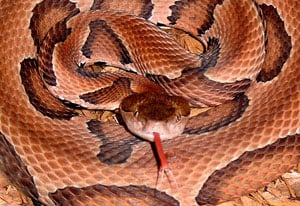
Here in Texas the venomous snakes fall into two categories: crotalids (the most common) and elapids. We’ll discuss elapid envenomation in a future article. Crotalinae is the subfamily for all rattlesnakes, cotton mouths, and copper heads. These are the snakes that come to mind when we think of snakebites.
Most snake bites occur for typically one of two reasons. The first being that the patient did not see the snake and accidentally stepped on it. The second reason is that they were trying to pick up the snake or play with it. This sounds very stupid but it does happen. A lot.
Don’t Panic
When most people encounter a snake, the first thing that usually happens is a healthy dose of adrenaline is dumped into their system. This can cause them to react in numerous ways, most commonly in panic. That’s without even getting bit! Now imagine how most people react once bitten.
The most important thing to remember once you are bit is to stay calm. I know this seems counter-intuitive, but trust me: this is the best thing you can do for yourself. Make sure that you have either killed the snake or backed away far enough that the snake is no longer a threat.
Signs and Symptoms
With the typical Crotalinae envenomation, the patient will have sustained any number of puncture wounds from the snake’s fangs. Other signs and symptoms include:
- Immediate burning pain
- Tachycardia (fast heart rate)
- Dyspnea / tachypnea (fast respiratory rate / difficulty breathing)
- Diaphoresis (sweating)
- Nausea and vomiting
- Generalized weakness
- Rubbery, minty, or metallic taste in mouth
- Erythema and edema (swelling and redness)
Treatment
The best treatment that you can initiate is to get your cell phone out and call 911!
If it is at all possible, wash the bite with soap and water. Make sure not to get any venom that is around the bite into any open wounds. Always keep the site of the bite below the level of the heart. This will help slow the spread of the venom.
It is extremely important that you can describe the snake to medical personnel. This will help determine the course of treatment.
DO NOT try the old cowboy method of taking out your knife and cutting the wound to try to suck out the venom! This only causes more tissue damage and if you have open wounds in your mouth you have just essentially received a snake bite to your mouth.
DO NOT tie a tourniquet above the bite. This just reduces oxygenated blood flow to the site and will make the envenomation worse.
DO NOT apply ice or cold compresses to the site. This will just cause more tissue damage due to the blood vessels constricting.
Snake Bite Kits
Snake bite kits can be bought in most sporting good stores. DO NOT waste your money on these. They typically have a scalpel, suction device, constricting band and alcohol wipe. The only thing of any benefit in these kits is the alcohol wipes, which can be used to clean the bite.
Antivenom
The only way to treat a Crotalinae envenomation is with an antivenom called CroFab. CroFab is only available in hospitals. It is given intravenously and only under strict observation by a doctor. It is very important that you advise the medical personnel if you have any preexisting medical conditions such as bleeding disorders, heart, lung or kidney conditions. These conditions will play a factor in your overall treatment.
Common Sense
Most of the information that I have shared with you is just good old fashioned common sense. Just remember to stay calm, call 911 and get to the hospital for definitive treatment.
Editor’s Note: Please join us in welcoming Jody Farr RN, LP, FP-C, CCEMTP as a contributor on ITS Tactical. Jody has been a paramedic since 1992, certified flight paramedic since 2006, critical care paramedic since 1998 and a RN since 2010. He currently works as a flight medic for an EMS flight service in the D/FW metroplex.
Jody is also going to be at the 1st Annual ITS Tactical Hog Hunt, presenting some info on proper usage of our ETA Kit for those of you attending!